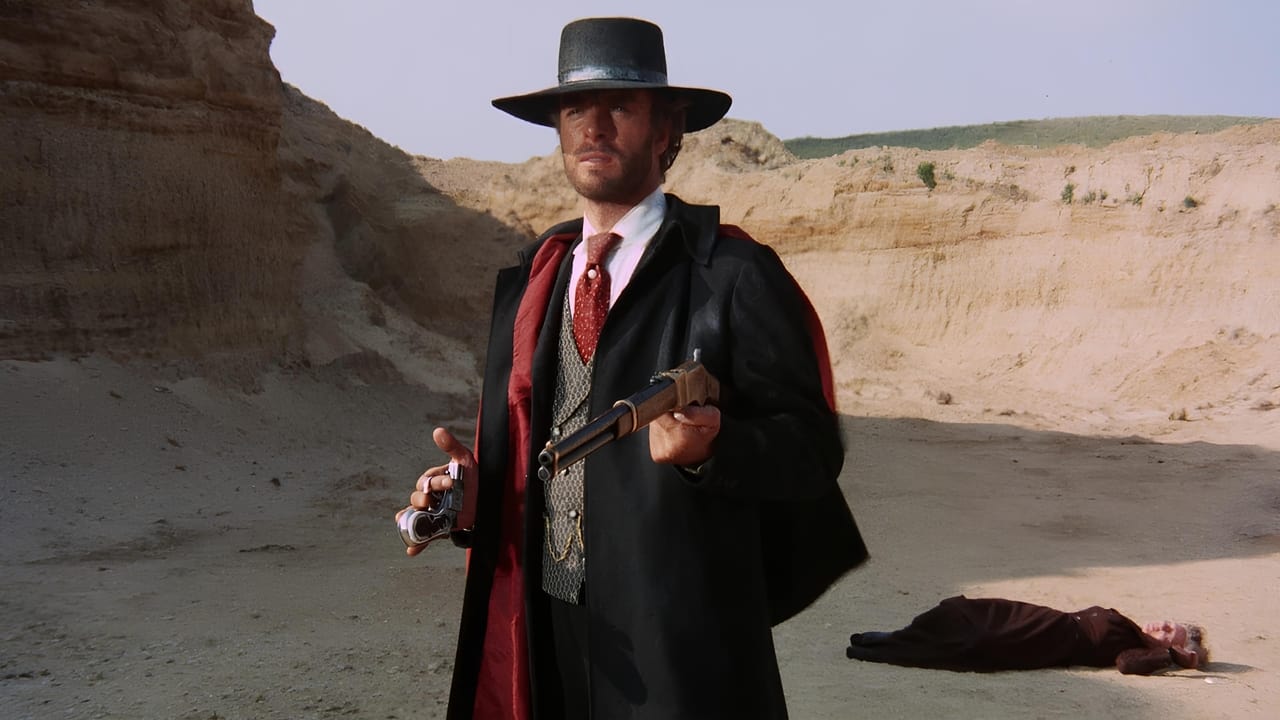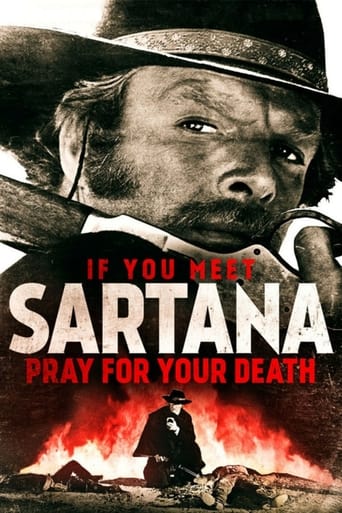

"If You Meet Sartana Pray for Your Death" (1968), directed by Gianfranco Parolini and starring Gianni Garko, William Berger Fernando Sancho, Sidney Chaplin(!) and Klaus Kinski phoning in a cameo role, has only one great thing going for it, and that's its ridiculously over the top title. The rest is a banal Spaghetti Western that has no tension and no direction.The script, such as it is, has a lot of incident and detail, none of which is interesting, as it is completely convoluted and very hard to care what happens to whom. Still, the plot is something like this: Sartana (Garko) gets involved with an insurance swindle run by several dignitaries, who hire a Mexican gang to steal a strong-box, and an American gang, led by Lasky (Berger), to kill the Mexicans.It takes a very long time, too long, to find all this out, and by that point, I ceased to care. Berger is a good actor, one that fits very well into the greed-fill world of Spaghetti's, but isn't given anything interesting to do and is wasted completely. Kinski obviously was doing his role for the money, which is a shame, as his is, career wise the best actor in the film. Garko has a good opening line ("I am your pallbearer."), but not much else, and doesn't have the same magnetic presence as Clint Eastwood or Lee Van Cleef.The director made "Sartana" and other "Circus" Westerns like this. They're called "Circus" Westerns because there is so much jumping around and choreographed back-flips that you might be watching a kung-fu movie and not a Spaghetti. The sets here aren't so much grand as big, to accommodate all the acrobatics; it has a hefty budget, but the desert scenes are shot in some quarry. Why? I suspect because Parolini was more interest in making an action film that just happened to be set in the West than creating a Western. These types of Spaghetti's were certainly very popular in their day, and they gave a lifeline to an ailing genre a few years later. I just wish the lifeline had been better. Maybe saying this movie is an insult to the genre is too strong, but when you see progressive and transcendent Spaghetti Westerns like "Black Jack" and "Once Upon a Time in the West" that were made in the same year, you realise how lazy this film is.
... View MoreIt is very obvious why Sartana created an avalanche of sequels, only second to Django. Even if it looks like yet another tale about stolen gold, Mexican bandits and switching allegiances, Sartana feels (and is) different. Of course seen back in 1968, it must have wowed European audiences with its bleak cinematography and nihilistic characters. However, 40 years (!) down the line, and it still feels as refreshingly dark and stylish as ever.As in with most spaghettis, the plot is near incomprehensible. It has something to do about a stolen shipment of gold and a constant switching of allegiances, as thief betrays thief to get the gold. But, again as in with most spaghettis, the plot isn't the issue at all.Sartana (1968) is a capsule of pure spaghetti western style. Everything is kept very minimal here, from the scarce dialogues, to the perennially empty town streets. Yet there's a hellish ambiance to proceedings and the nonsensical plot only adds to its psychotronic charm. I gave up trying to follow the plot after a while and just immersed myself in the surreal happenings.Sartana himself is like a crossover between The Man with no Name (the standard by which every spag antihero is measured) and Django, a black-clad amoral anti-hero. He's not out there to catch the baddies. He's just out for money and blood. His quirky gadgets often bring to mind the other Parolini character, Sabata, but Gianni Garko's character plays on a whole other level. There is of course, the occasional comic relief, in the form of an old gravedigger, but it only confirms that Sartana is indeed a grim western. That same darkness would resurface in Clint Eastwood's High Plains Drifter years later, on the other side of the pond.Overall, this is a must see for SW afficionados. If you're a fan of Corbucci's nihilistic side (Django, The Great Silence), Sartana will make you cream your pants. Dark, stylish, with a streak of Euro horror running through it, Sartana is a criminally forgotten piece of celluloid. Watch it and find out.
... View MoreNice Spaghetti Western. The story concerns four rival groups out to get a chest full of gold. While the plot is actually almost incomprehensible, it's fun to watch Sartana and others switch allegiances about every five minutes. But the story here is secondary to the action. The body count is very high with entire gangs being wiped out by the burst of a Gatling gun. Gianni Garko as Sartana and William Berger as Lasky are just fun to watch. It's not the best Spaghetti Western I've seen, but I'm glad to finally have a copy.While the movie prominently lists Klaus Kinski in the credits, his screen time totals about 10 minutes.
... View MoreFrank Kramer's SARTANA (1968) has emerged as one of the most interesting examples of the classic era Spaghetti Westerns and yet exists as a sort of exuberant failure, reveling in it's sense of artiness & bad taste at the same time. Yet it's an important failure, a movie that spawned a recurring character and helped to shape the Spaghetti Western into a genuinely "adult" form of cinematic entertainment. The film was classified with an "X" certificate in much of Europe when first released and only made it's way to English speaking audiences in a somewhat diminished cut -- and has now been released by indie Spaghetti Western label Wild East Productions on DVD in it's complete form, and demands some re-evaluation. When I first encountered this movie I was admittedly caught up in a wave of excitement about the film's look & style. Here is a pretty much pure example of the Spaghetti Western, made entirely in Italy by an all European cast with no standout Yankee Gringo star turn, unless you count Klaus Kinski's ten minutes or so on screen. Gianni Garko headlines as Sartana in the second of five screen outings by him as a character named "Sartana" but the first from the loosely related series featuring Sartana as a hero: 1966's $1000 ON THE BLACK depicts Sartana as a crazed, barbaric killer and is not related to the Good Guy Sartana movies ... or so the thinking goes.Sartana's character in this first Good Guy outing is actually more successfully realized than the movie he inhabits, which tells a sort of labyrinthine plot by various bigwigs in a tumbleweed nowhere to intercept a shipment of gold & screw each other over for their percentages, resulting in murder and mayhem: the usual boring stuff. What works is Sartana's character fleshed out by Garko: A black garbed, laconic, mysterious gunfighter who appears out of nowhere with motives all his own and no past history (perhaps the ghost of the original Sartana, sent back to atone for his sins on Earth??). Yet he seems to know what everybody in the movie is up to and has a plan to play the different sides against each other & move in once the dust has settled to pick up the pieces for himself like a Hyena, which is how one character aptly describes him. Sartana is there to preside over the deaths, and make sure everyone gets buried in style.This is done with a minimum of dialog, an emphasis on mood and a staggering body count for a movie of such limited scope. Which plays out very much like an arty, dark-toned cartoon or graphic novel, with Sartana as a sort of Batman like avenger who takes justice into his own hands. Garko wears his Sartana personal like a tailored suit, even perfecting a way of turning while gazing up from underneath the brim of a hat that reminds me of watching a cobra moving with a snake charmer. He also has more in common with James Bond than Clint Eastwood, armed with a small pepper-box type Derringer pistol that behaves more like a movie prop than an actual weapon, and more often then not scheming his way out of a jam or around his adversary's flanks. He is the epitome of "cool" as a Spaghetti Western anti-hero, and it is easy to see why his performance spawned a series.The film also boasts a first rate A-list supporting cast of genre veterans: the crazed William Berger, Sydney Chaplin, Spaghetti Western legend Fernando Sancho, Andrea Scotti, Sal Borgese, and of course Klaus Kinski. One of the attributes that gives the film a decidedly surrealist bent is Kinski's "performance", which appears to have been filmed over the course of a long weekend without anyone else present on set but Kinski. Watch him in the barbershop scene: He appears to be dialing it in from another dimension, and in all is on-screen for about ten minutes. What a way to make a living. The later "Sartana" movies directed by Anthony Ascott became increasingly cartoonish but this film has a dark, nasty, almost sadistic side to it that is quite special. I would almost refer to it as "mean spirited", and filmed on a shoestring budget that allowed no quarter for artifice. The offbeat musical score by Piero Piccioni is uniquely un-cinematic with an organ as the central instrument instead of the usual Morricone flavored bravado, and most of the outdoor scenes were filmed near a dump outside of Rome. You can see the green yucky chemicals polluting the pond around which one scene is set, which seems appropriate for a ghoulish, overtly violent cartoon. Or even a horror movie.8/10 for Spaghetti fans, 5/10 for everybody else, and a classic of the genre any way you slice it.
... View More